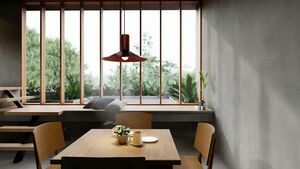The Japandi trend, which combines Scandinavian and Japanese culture, is found in more and more contemporary interiors and allows for a modern and aesthetic universe. What is it all about? How do the different styles work together and how can you adopt this current trend in your home? You will find out everything in this article.
The Japandi style, what is it?
A current decorating trend that has made its way into many interiors, the Japandi style refers to a subtle blend between Japanese and Scandinavian styles. Characterised by its refined, sober and simple appearance, Japandi is mainly inspired by the harmonious well-being drawn from the Zen philosophy of Japanese wabi-sabi and hygge, an omnipresent concept in the art of living of Nordic inspiration. The balanced combination of the two cultures, although geographically distant, allows the creation of a cocooning and soothing interior where nature and light reign supreme.

Zen atmosphere
How do Japanese and Scandinavian styles combine?
In terms of interior design, if there is one thing that Japan and Scandinavia share, it is a respect for nature. It is therefore the latter that remains the main element of the Japandi style, which is reflected through the use of natural materials such as wood to dress the various rooms of the house. In terms of colours, dark tones such as aubergine purple, dark green, black or terracotta red recall the Japanese influence and should ideally be combined with more neutral tones to recall Scandinavian design. The fusion of the two trends thus makes the interior elegant, warm and uncluttered for an authentic whole.

Scandinavian design and Japanese influence
How to adopt the Japandi style at home
If you too wish to adopt the Japandi trend in your home, here are some tips that will allow you to create a harmonious universe, shared between the hygge and wabi-sabi philosophies.
The choice of colours
As you will have understood, the objective of the Japandi trend is to make your interior soothing and zen. To adopt it, the choice of colours represents an important first step. This style, which mixes warm and deep colours with the cooler and more neutral colours of the Scandinavian style, will allow you to combine white, beige, light grey, charcoal grey, earthy brown or a pastel colour with camel, ochre, taupe, terracotta or one of the other warm colours mentioned above. If you have a lot of plants, you will also have the option of using midnight blue or Prussian blue to give the impression of a river, or emerald green to further enhance the plant environment and enjoy a warm Nordic-Japanese atmosphere.

Mix of dark and warm colours
Prefer natural materials for the Japandi trend
As the Japanese style puts nature in the spotlight, natural materials should be preferred for your furniture, textiles and objects. You can choose terracotta, wood, rattan, wicker, rice paper, silk, velvet, cotton, etc. If you are planning to redo your floors or if you are in the process of building, don't hesitate to choose waxed concrete, wood, bamboo strips or cork. For the walls, ideally choose materials such as ecological paint, wallpaper or plant fibre panels which will be both aesthetic and functional. For furniture, if simplicity is what characterises the Japandi style, it must above all be of quality and bring an authentic side to your interior. So don't hesitate to match the Nordic style with the Japanese style by playing with curves, graphics and tones. For your tableware or decorative objects, porcelain and ceramic are safe and timeless values.

Noble and natural materials
The choice of furniture
Adopting a simple and sober style does not mean sacrificing comfort, the choice of your furniture should be in line with your lifestyle. While you can opt for natural materials such as light wood like bamboo or oak, depending on your tastes and preferences, you can also opt for darker woods like acacia or teak for furniture such as a coffee table, chest of drawers, sideboard or bookcase. The central element of your living room is the sofa, so choose a light-coloured velvet or cotton model such as beige, cream or ecru, which you can contrast with darker cushions or plaids such as black or navy blue. A rattan armchair placed in a bedroom or living room next to a wicker planter will also look great. On your shelves, don't hesitate to place a few simple, handcrafted decorative items with a contemporary design and a real function without cluttering the space (photo frame, candle, etc.).
Bring a floral note to your home
Naturalness being the element that unquestionably characterises the Japandi trend, when adopting this style, indoor plants are undoubtedly among the essentials. Pampas grass, bonsai or even cherry branches placed in pretty ceramic vases in neutral tones can only guarantee an atmosphere perfectly conducive to relaxation.
Japanese style lighting
As light is an important element of the Japandi style, you can of course opt for light coloured curtains to let in as much natural light as possible in the house. But for darker days or evenings, light fixtures are particularly important. In order to combine the Nordic and Japanese worlds, you can choose lamps, hanging lamps or wall lamps with a natural look that will perfectly fit in with your decor to enhance each room and create a cosy interior. If possible, to create a perfect Japanese style interior, avoid flashy lighting and choose pendant lights that will create a soft and subdued atmosphere.

Hanging lamp in japandi style
In conclusion, the Japandi trend represents a hybrid interior design style that combines Scandinavian and Japanese allure to create an elegant, sober and pure universe. This trend, which places nature as the main element, implies a selection of natural materials and a combination of colours that are reminiscent of both styles with a harmonious balance.












